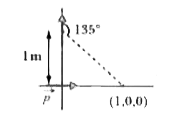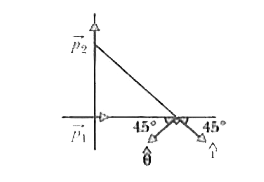We have studied that the electric field and potential both obey the law of superposition. We can find the electric field and the potential due to each of the dipole at the point concerned and then add them. The caution to be exercised is that while finding the electric field/potential due to a given dipole, we need to consider the center of that dipole as the origin.
Calculation: Due to the first dipole at the origin, the potential is
`V_1 = (kp cos theta)/( r^2) = ( kp)/(1^2) = kp`
Due to the second dipole at y = 1, the potential is
`V_(2) = (kp cos theta)/( r^2) = ( kp) /( sqrt(2)^2) cos 135^(@) = (kp)/( 2 sqrt2)`
Therefore,
`V= V_(1) + V_(2) = kp- (kp sqrt2)/( 4)" "`. (Answer)
Similarly, the electric field in the radial direction due to the first dipole is
`E_(r 1) = ( 2k p cos 0)/( r^3) overset(^) (i) = 2k p overset(^)(i)`.
Here, the radial direction is also the x direction as can be seen from Fig. 24-35.
`E_(p1) = ( 2k p sin 0)/( r^3) overset(^) (j) = 0 overset(^)(j)`.

Here, the polar direction is the positive y direction.
The magnitude of the electric field in the radial direction due to the second dipole is
`- cos 45 overset(^) (i) - sin 45 overset(^)(j) E_(r2) = ( 2k p) /( 2 sqrt2) cos 135^(@) = - (kp)/(2).`
Here, the radial direction is shown in Fig. 24-36. A unit vector in the radial direction will be cos `45overset(^)(i) - sin 45 overset(^)(j)`. So,
`E_(r2) =- (kp)/(2) ((overset(^)(i))/(sqrt2) - (overset(^)(j))/(sqrt2)).`
Similarly, the electric field in the polar direction will be given by
`overset(to) (E_(p2))= (kp sin 135^(@) )/( ( sqrt2)^(3)) (- (overset(^)(i) )/( sqrt2)- (overset(^)(j))/(sqrt2))`.

Because a unit vector in polar direction will be `- cos 45 overset(^)(i) - sin 45 overset(^)(j)`, so we have
`overset(to)(E) = 2kp overset(^)(i) - (kp)/( 2 sqrt2) overset(^)(i) + (kp)/( 2 sqrt2) overset(^)(j) - (kp)/(4 sqrt2) overset(^)(j) - (kp)/(4 sqrt2) overset(^)(i) - (kp)/( 4 sqrt2) overset(^)(j)`
`=((kp (8 sqrt2 - 3 )overset(^)(i) )/(4 sqrt2) + (kp overset(^)(j) )/(4 sqrt2) )." "` (Answer)

